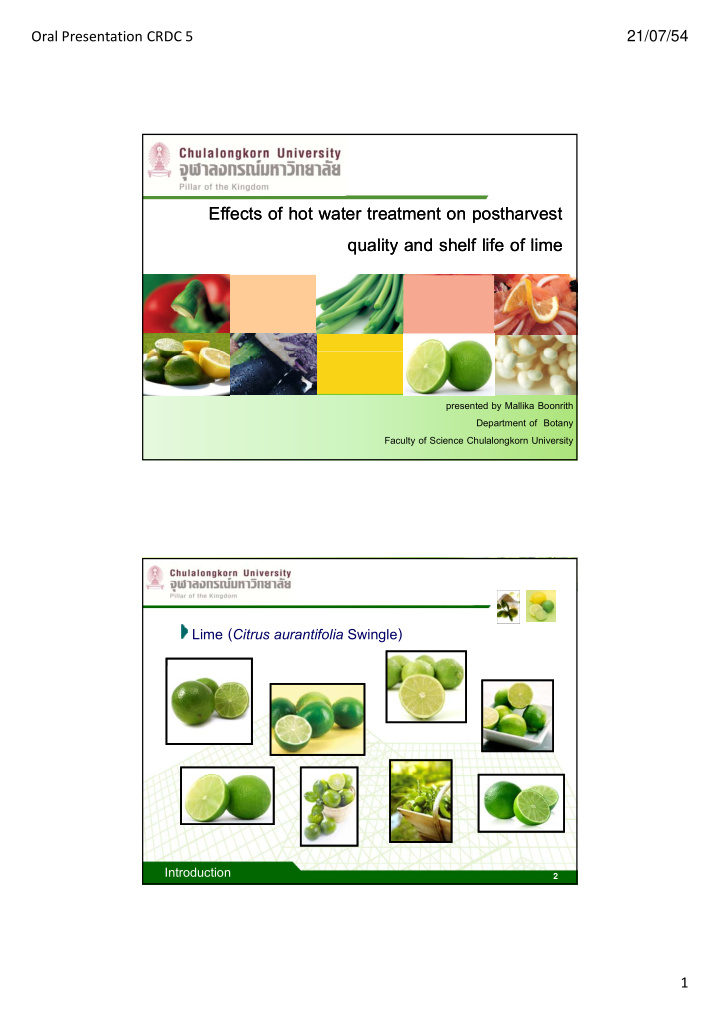



Oral Presentation CRDC 5 21/07/54 Effects of hot water treatment on postharvest Effects of hot water treatment on postharvest quality and shelf life of lime quality and shelf life of lime quality and shelf life of lime quality and shelf life of lime presented by Mallika Boonrith Department of Botany Faculty of Science Chulalongkorn University LOGO LOGO Lime ( Citrus aurantifolia Swingle) Introduction 2 1
Oral Presentation CRDC 5 21/07/54 LOGO Heat treatments non-damaging physical treatments hot water, vapor heat and hot air delay ripening prevent insect pests and fungal rots Introduction 3 LOGO Plant Treatment Storage Result Lemon Hot water dipping 13 ºC for Only 15% rot (Rodov et al 1994) (Rodov et al.,1994) 53 C for 3 min 53 ºC for 3 min 6 weeks 6 weeks Lemon Hot water dipping 2 ºC for Decrease (Porat et al., 2000) 52 ºC for 2 min 8 weeks decay and chilling injury Satsuma mandarins Hot water dipping 5 ºC for Decrease (Hong et al., 2007) 52 ºC for 2 min 3 weeks decay 55 ºC for 1 min then 18 ºC 60 ºC for 20s for 1 weeks Introduction 4 2
Oral Presentation CRDC 5 21/07/54 LOGO Objective To determine an optimum temperature and period of hot water treatment for prolonging shelf life of lime storage prolonging shelf life of lime storage 5 LOGO Materials and methods Plant materials no disease, wound or bruise uniformity of size and peel color Hot water treatments hot water dipping at 40, 45, 50 and 55 ºC for 2 and 5 min distilled water dipping was used as a control storage at 10 ºC for 6 weeks and 25 ºC for 4 weeks 6 3
Oral Presentation CRDC 5 21/07/54 LOGO Treatment 1 control for 2 min. Treatment 2 control for 5 min. storage at 10 ºC for 6 weeks and Treatment 3 40 ºC for 2 min. Treatment 4 40 ºC for 5 min. 25 ºC for 4 weeks Treatment 5 45 ºC for 2 min. Treatment 6 45 ºC for 5 min. measure every Treatment 7 50 ºC for 2 min. Treatment 7 50 ºC for 2 min 7 days until 4 and Treatment 8 50 ºC for 5 min. 6 weeks Treatment 9 55 ºC for 2 min. Treatment 10 55 ºC for 5 min. Materials & methods 7 LOGO % Weight loss Peel Color Minolta Chroma Meter (CR-10) L Value and hue angle Disease rating at 1 to 5 score with 1 = less than 5% 4 = 61-90% 2 = 6-30% 5 = more than 90% 3 = 31-60% All data were analyzed by ANOVA. When differences were significant (P>0.05), individual treatment means were separated using Duncan’s Multiple Range Test (P=0.05). Materials & methods 8 4
Oral Presentation CRDC 5 21/07/54 LOGO A B C Limes stored at 10 ºC for 6 weeks (A), control 2 min (B), control 5 min (C), 40 ºC 2 min F D E (D), 40 ºC 5 min (E), 45 ºC 2 min (F), 45 ºC 5 min (G), 50 ºC 2 min I G H (H), 50 ºC 5 min (I), 55 ºC 2 min Results 9 LOGO week 1 st week 6 th Results 10 5
Oral Presentation CRDC 5 21/07/54 LOGO 3.50 B AB AB 3.00 AB AB AB (%) A A A 2 50 2.50 weight loss 2.00 1.50 1.00 0.50 0.00 Percentage weight loss of limes stored at 25 ºC 4 weeks Results 11 LOGO 4.50 C BC BC 4.00 ABC ABC ABC AB AB (%) 3.50 A weight loss 3.00 2.50 2.00 1.50 1.00 0.50 0.00 Percentage weight loss of limes stored at 10 ºC 6 weeks Results 12 6
Oral Presentation CRDC 5 21/07/54 LOGO 12 11 10 s rot number of fruit 8 6 4 4 4 4 3 3 3 2 2 1 0 0 Rotting of limes after incubation at 25 ºC for 4 weeks. Results 13 LOGO Discussion Schirra and D’hallewin (1997) reported that ‘Fortune’ mandarins dipped at 58 ºC for 3 min delay color changes Broccoli through dipped at 45 ºC for 4 min to delay color changes (Dong et al., 2004) Hot water treatment at 52 ºC for 3 min have been shown to reduce green mold in organic lemon inoculated with the spores of Penicillium digitatum (Lanza et al., 2000) 14 7
Oral Presentation CRDC 5 21/07/54 LOGO Conclusion 10 ºC 40 ºC for 5 min 25 ºC 15 LOGO Acknowledgements This project was supported by the Thai government budget 2011, under the Research Program on Conservation and Utilization of Biodiversity and the Center of Excellence in Biodiversity, Faculty of Science, Chulalongkorn University 16 8
Oral Presentation CRDC 5 21/07/54 LOGO Thank you Thesis Advisor : Teerada Wangsomboondee, Ph.D. Thesis Co-Avisors : Assistant Professor Kanogwan Seraypheap Ph D Assistant Professor Kanogwan Seraypheap, Ph.D. 17 9
Recommend
More recommend